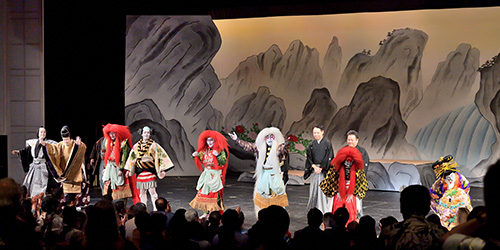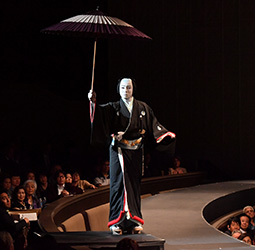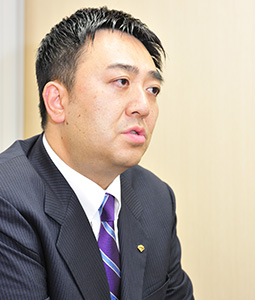Home > Highlighting JAPAN > Highlighting Japan July 2017 > Evolving Traditions
Highlighting JAPAN


Kabuki: New Frontiers
Kabuki is embracing cutting-edge technology to open new frontiers and make the traditional Japanese theatrical art form accessible to a wider audience.
Kabuki has a history spanning more than 400 years. Inscribed on UNESCO’s Representative List of the Intangible Cultural Heritage of Humanity in 2008, kabuki is one of the major classic theaters of Japan. One company which has played an important role in keeping the art of kabuki alive is Shochiku Co., which is the only production company and promoter of kabuki, and operates the Kabukiza Theatre.
In 2016, Shochiku teamed up with Panasonic Corporation and Nippon Telegraph and Telephone Corporation (NTT) to produce and present a daring production called “KABUKI LION SHI-SHI-O” (The Adventures of the Mythical Lion) and “Cho kabuki: Hanakurabe senbonzakura — Konjyaku kyoen senbonzakura” (Cho [ultra] kabuki: Contest of a thousand cherries — Banquet of a thousand cherries in times past and present)” with DWANGO and NTT. Both productions were acclaimed for the huge potential they demonstrated through their fusion of kabuki and cutting-edge digital technologies. In February 2017, Shochiku received the inaugural Cool Japan Matching Award grand prix, which recognizes excellence in collaborative initiatives between various industries seeking to spread Japanese culture overseas.
Such collaborations are part of a trend. Thanks to new initiatives such as the Super Kabuki plays pioneered by Ichikawa Ennosuke III since 1986 and Nakamura Kanzaburo XVIII’s Heisei Nakamura-za troupe, which has had great success including performances in New York, kabuki is spreading to a wider audience.
Noma Ippei, executive officer in charge of theater development and promotion at Shochiku, presided over the reconstruction of the old Kabukiza Theatre built in 1950 and the opening of Kabukiza Theatre and Kabukiza Tower in 2013. Noma frantically searched for a tenant for the Tower that would help keep Japanese traditional culture and kabuki alive, before DWANGO, which runs Niconico, a Japanese video sharing site, decided to move in. This decision led to the realization of “Cho kabuki.”
“We had a difficult start looking for tenants due to the global financial crisis,” says Noma with a wry laugh. “But we caught the attention of DWANGO’s founder and chairman Nobuo Kawakami, and DWANGO decided to move in. DWANGO executives then saw "Super Kabuki II: One Piece” in 2015 and sounded us out about the production at the Niconico Chokaigi festival.”
Niconico Chokaigi, launched and established in 2012 by DWANGO, is an audience participation-style event which recreates Niconico’s virtual world in real life. Held over two days at the Makuhari Messe convention center in Chiba Prefecture, the event showcases a wide variety of content and has proved very popular. In 2017, over 154,000 people visited the event and over 5,059,000 people participated online.
Shochiku decided to collaborate on “Cho kabuki” at the 2016 festival at the request of DWANGO, creating performances with DWANGO starring the popular kabuki actor Nakamura Shido alongside virtual singer Hatsune Miku.
The decision to combine these two apparently disparate genres was based on the common theme of “one thousand cherry trees,” namely Hatsune Miku’s hit song “Senbonzakura” and the kabuki play “Yoshitsune senbon zakura” (Yoshitsune and the thousand cherry trees). However, Nakamura Shido initially knew nothing of Hatsune Miku.
Conscious of the importance of tradition in kabuki, Noma says, “We explained to Shido-san that, because of Shochiku’s involvement, the production would be true to kabuki theory. The actual staging does not stray from the theory either."
In addition to DWANGO’s special effects, the staging used NTT’s immersive telepresence technology called “Kirari!” which captures images of live actors and transmits real-time holograms of them as acting avatars. The fusion of traditional culture and cutting-edge technology is a new form of expression and the main attraction of the productions but at the same time it is also the part which is called into question.
According to Noma, “This doesn’t apply to cutting-edge technology alone, but it all boils down to ensuring that creators do not become complacent and to asking ourselves how we can communicate with audiences in a way they can understand.”
In these collaborative productions, Noma received a certain reaction that showed the creators’ feelings were being communicated to the audience. In kabuki theater, at the climax of a play the spectators call out the house name, or yago (stage name) of the actors in praise of their performance. At the collaborative productions, spectators shouted out “Yorozu-ya!” (House of Yorozu)” for Nakamura Shido, “Hatsune-ya!” (House of Hatsune) for Hatsune Miku, and then “denwa-ya!” (House of NTT) for Kirari!’s performance.
In April 2016, a performance of “KABUKI LION SHI-SHI-O,” with the popular kabuki actor Ichikawa Somegoro playing the lead, was held in Las Vegas in the United States. The first part of the localized kabuki play was performed digitally with the actors delivering part of their monologues in English. The nagauta, the songs which accompany the kabuki theater, were also partly sung in English. The performance was a hit, with many in the audience seeing kabuki for the first time.
According to Noma, one of Shochiku’s primary objectives for trying a new form of kabuki theater was to broaden kabuki's audience base. “I think it’s good to have a diverse theater-going population. Also, in terms of bringing people from overseas into contact with kabuki ahead of 2020 when Tokyo hosts the Olympics and Paralympics, we hope that many different kinds of people come to see kabuki.”
Shochiku has been staging kabuki theater productions overseas for nine decades since 1928. It is now harnessing this experience to pursue the huge potential of the genre in 2020 and beyond.

© 2009 Cabinet Office, Government of Japan








